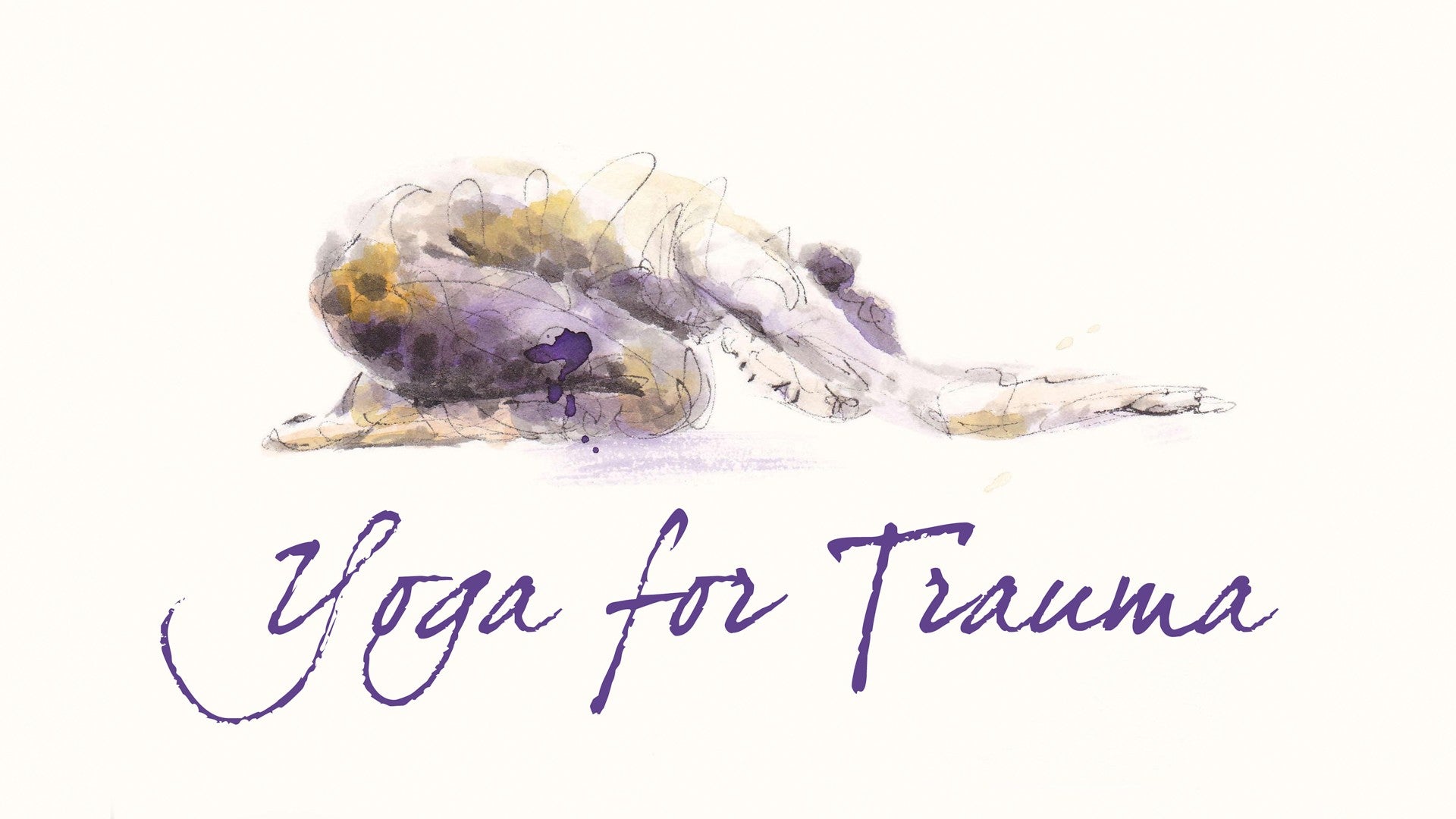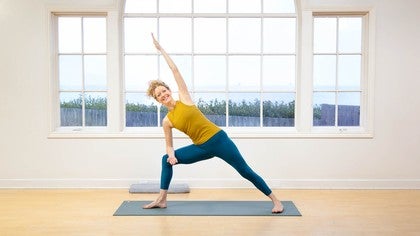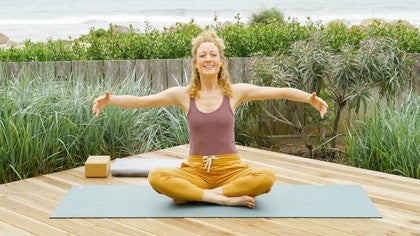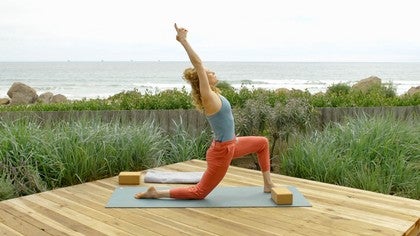Description
About This Video
Transcript
Read Full Transcript
Hi there. In this episode, we are going to get serious about nervous system regulation via an approach to yoga practice that fires up the entire brain and creates a greater sense of wholeness and creativity within the self. We're going to do it through play. Research shows that play fires up the frontal lobe. It also develops contextual memory and increases survival strategies as well as resilience.
Play is how humans, for thousands of years, have learned how to cultivate safety with one another and trust. In the mental health world, it's said that play is the opposite of depression. Let's jump right in. We're going to start seated today, and of course, as with any other practice, you listen to your body and start as you need. Wherever you're finding connection here, it might take a minute, sometimes I even just tactilely bring some awareness to my mat, to the earth underneath me, to the bee that's on my mat.
Just feel where support is. You might even either steady the gaze at a point or close the eyes, and we're going to start by allowing some opening into the imaginative play centers. Consider imagining yourself in a body of water that's the right temperature, the right space. I have an incredible ocean behind me. I'm thinking about that.
Remember, this is a visualization, so you are entirely safe here. You might imagine what it would be like to just sway with some of those gentle waves. That sway might start in an almost imperceptible way to the rest of the world, just a little movement of the head or the neck, a softening in the jaw. You might allow the rib cage to shift or the weight to shift in your sitting bones. Having the ocean right behind me, I'm taking a cue from nature, thinking about kelp, this thick but flexible seaweed that just rolls with the water.
For a moment, you might imagine and even allow your body to play with the idea of sway as if you were a piece of kelp. Yep, sometimes closing the eyes helps suspension of disbelief, so go with it. Allow the body to feel the felt sense of what it's like to move with fluidity. There you go, might be in the joints or in the hands. It might be a forward, a side movement, an upper and down, just sense that.
Now if kelp isn't your jam, that's okay. Let yourself expand to imagine what other sort of sea creature, an enemy you might become. Just notice these pulses that are a part of your sway or a movement. This movement, if you think about it, is really the opposite of a fight or flight or freeze response, yeah? So now we're going to take this into a little bit more mobilization and however you find it staying in your sea creature, your kelp-like identity, consider bending the knees and allowing yourself to kind of pulse up onto the tops of the sitting bones and then recline back a little.
You might lift a limb, just going with the sway. There's a part of the brain that really doesn't know the difference between an actual experience in a memory or an imagination. It's deep in that limbic brain that also helps code memory. So if your body has a felt sense of floating and swaying, there's a part of your nervous system that's going to take that in. And then when you're ready, let yourself take your sea creature all the way down to the earth and then maybe expand, stretching out in all directions.
We're going to bend the knees and lift the arms and the legs up into the water. And now I'm becoming a sea turtle. Go with what works for you. Because sea turtle on its back, there's little sea otters actually out in the ocean behind me right now. You might imagine those little sea otters who are incredibly playful social critters also.
What that's like. Nice. And then gradually we're going to reach the left leg up and place the right foot down and just pause as we move out of more of the sway or the fluidity. And sense what it's like to have more stability or earth underneath you again. Dropping the sitting bones, lengthening through the back of the leg and the hamstring.
You are welcome to extend that opposite leg as well. Take a deep breath in. After opening your mouth, allowing the throat to sigh out any extra tension. Now we're going to change. Dropping the sitting bones, drawing the front thigh forward as you lengthen through the back heel.
And as you approach into different pockets of intensity in the body, just notice what your relationship is to it right now. See if you can cultivate that element of curiosity. What would it be like to be with intensity and still breathe? Remembering that we can come out at any time. Beautiful.
Hug both knees into the chest. Rock a little bit side to side. Yeah. I'm going to place the feet down, scoot your hips over to your left a few inches. I'm going to bring my left knee in and stretch the right leg down.
Consider playing with the hip to open and cross it over just halfway. We'll do that one more time, open. Let the knee come across the body and allow it to fall down onto the earth wherever it is. There's no force necessary here. See if you can prioritize the upper back, the shoulders on the ground, rather than the knee all the way down to the earth.
If you could sense the support and yield into that, how would that feel? Where does the breath have possibility of going in this space? Now on your next exhale, and wait for the exhale, come onto your back. Slide the hips right to the center and pause. We're going to change sides.
Drawing the right knee in, draw it open, across the body halfway, open, and playing with the twist. Some of you might even put, I've got a prop conveniently located right here. Let the shin fall onto a blanket or a block. And again, we're going to prioritize the shoulders and the arms rather than the knee being jammed down. And if you could yield to gravity, even just play with the potential of letting your bones get heavier, what does that facilitate, if anything, in you?
If you're noticing you need more agency or you're feeling disconnected, how might you activate yourself, your breath, your presence, your gesture to come into present moment? Okay, now I'm going to ask you to get a little curious and a little creative on how you want to turn over onto your stomach. I'm going to imagine just like rolling, feeling my whole back body on the ground, and pressing over onto the front. And feel free to wiggle a little bit. The pressure and the internal organs, the hip bones.
As you breathe, you might imagine the belly getting as big as a balloon here in all directions. And then the exhale contracting, deflating back down to earth. Do that one more time, allow the diaphragmatic breath to come in. And again, opening up the mouth, a little sound. I'm going to bring the hands out a little wider than usual.
Come up onto the fingertips. Let's roll the shoulders up, back, and down. Energize through the leg and like a snake. Go ahead and lift up. Now if snakes are not your thing, okay.
Just feel the oppositional energy drawing forward and back at the same time, hugging into yourself and expanding in both directions. We're going to press back to the child's pose for just a moment. Lengthen through your back. Maybe there's a breath in the back of the ribs here. Awesome, come on up.
And now, sense what it's like to be on all fours. We're going to play again with some animal creatures. So let's come onto the pads of the fingertips a bit more, almost like you're gripping a little and the wrist could lift. Consider lifting your knees off the ground a few inches. Now this is optional, never an obligation, so your knees can also be on the floor.
But if you're here, you're going to start to crawl forward and just imagine what your bare self might be like. Or if there's another animal that's coming through you, that's all cool. The power of staying kind of low to the ground and moving bilaterally, which can be great for the brain. Now take your bear, take your animal, whichever one it is, maybe off the boundaries of the mat. See what it's like to go out of bounds for a second.
Maybe crawl back around and then change the speed, maybe a little bit faster, slower. How's the heart rate? Good, now we're going to pause. Go ahead and pause in your downward facing dog or your child's pose. Broaden the collarbones, let the brain release for a moment.
The head brain release, release the tongue, and take a few breaths here. And in whatever shape you've paused in, just take a moment to check in with yourself. How's the energy? Where's the mind? Bring it back to here, this breath if you can.
Now we're going to step the right foot forward in just a moment. I'm going to set myself up and put a blanket underneath my knee, pad up, use whatever prop you need to support your knees. But we'll just step the right foot forward, back knee down. I'm also going to use a block now, it's optional. Put the block on the instep of the foot for my left hand.
Allow the psoas, the front of the back of the left hip, to just gently sink towards the floor. Now at the same time I'm still pressing down in my front heel and thinking about lifting my hips gently. As you're ready, you might rock the hips back, almost like you're moving into a downward facing dog with pelvis, keep your left arm reaching. Consider reaching the heart forward as well. Now we're going to bring the right hand to the hip.
As we draw the little toe back, think about ringing around your middle line, kind of ringing out the spinal column as if it were a wet towel. The head can be soft, open, notice how your breath is. If you're not breathing, stop this practice, attend to that, and then when you're ready come on back. We're going to change sides, change sides however you want. Some of you might do a jump switch.
Some of you are going to lift one leg or crawl one leg. But this is your practice, this is your body, your heart, your mind, you're allowed to play with it. And taking a moment to allow that right front hip flexor a moment to release. As you do that, what's happening in your jaw, your ears. And then we'll rock the hips back, drawing the sitting bones back, the heart forward.
Consider bringing your little toe side of the foot more towards the hip, and then ringing around the midline. How are those shoulders? What would it be like if you could bring the shoulders onto the back and still feel the length of the spine? There's so much happening here, right? If you happen to fall out of it, cool.
Breathe, you might say, success. I borrow that from the yoga circus people. Reframing what it's like to succeed or not. We're going to fold our props off the mat or move them off the mat now. Step all the way up to the front, bow the body.
As you're ready, come on up to standing, inhale. Now consider just letting your arms swing, the knees bend, up again. One more. And then reach, reach, reach, extend this moment. Exhale to bow.
Surya namaskars or sun salutations, inhale, lengthen the spine, are about connecting to heat, but also connecting to joy. So move back through your Surya namaskars you need, maybe knees up or down to the earth or chaturanga. Just breathing with each movement. Step, jump, hop all the way to the front, bow in, rise up, return home, hey there. Let's step open wide.
Let the arms extend and go ahead into like a superstar. Now as you do this, be mindful of your low back, right? So still, even though you're a superstar, descend the sitting bones down and lift the front of the hip flexors. And now come on back in, almost like you're a starfish coming into yourself. We'll do that two more times.
Today your range of motion might be as big as it's ever been. And today your range of motion might just be playing in a smaller field. All of it's good. Wherever the nervous system is at, it's good. We just want to accept ourselves exactly as we are.
There you go. Come on in. And now we're going to bring the hands to the hips and just let the hips start to move. Yep. Some of you are like, what?
I've got hips? What do they do? Others of you have been waiting for this all week long. So maybe making a couple of circles, that's it. Both directions.
Both directions. I'm unlocking my knees so this doesn't go into my low back. And if you're feeling really curious, maybe making some figure eights with the hips. Yeah. And then what happens to the rest of your body as you try to figure out this movement?
Okay. At this point, you might pause this practice and just turn on music and get down. Others of you are going to keep going with me and just shake this off. And just check out levels of endorphins that might be in the body right now. Just as we're getting curious and creative here.
I'm going to take you into another practice that I've done over many different times in my life. My favorite way of doing this is super playful and it comes from a somatic practitioner brother of mine, Ilya Merik, and it's the teacup practice. More from Qigong. So let your feet be wide, soft, supportive, and steady. And I want you to imagine up there, up there, is this magical realm of teacups and tea.
I want you to hold out your hands, these incredible hands that have been just doing so much work for support and protection for you. And imagine teacups just fall right down into your hands. And look at your teacups. They're the most incredible magical teacups you've ever seen. Now magic tea comes into them, right?
Might be a elixir of vitality, goodness, sweetness, right? Whatever it is, you are holding something precious. You're holding something important. So don't let that tea drop, okay? Notice what happens in your shoulders.
Is there a way to trust the earth? Is there a way to still notice the fluidity of your hips? Let's take the right arm and we're going to go across the body holding our teacups and bring it out like a circle and back in. Go to the left, across the body, hold your tea, let it come back in. Now bring your right arm behind, yeah, oh yeah, oh yeah, right arm behind, okay, bring it back.
Okay, let's do the left hand behind. Keep the tea, keep the tea, oh, what's happening in the other hand? And behind. All right, now both arms in front, holding your teacups, not letting them spill. Both hands behind, uh-oh, uh-oh, are you ready?
I see you, some of you dropped some tea, okay, let it be poured back in, we'll try it again. The arms behind, up overhead, one more and notice what your hips have to do. I'm getting really low, all right, in order to keep my teacups up, okay, we'll go in the opposite direction, which I think I just spilled all my tea right there. I'm gonna do one at a time. So now just playing with the arms, playing with your teacups for another 10 or 15 seconds.
Working through space with the breath, letting the stability of the legs, the ribcage, the breath hold you and then come on back. You made it, no one dropped their cups. We're gonna send them back up for safekeeping, are you ready? One, two, three, go. All right.
Now however you would like to, I'm gonna invite you down onto the mat, down onto your back. I'm just gonna do like an elevator lower, but you might take a vinyasa and we're gonna move ourselves onto the back. And as we come down here, I wanna invite you to finish the practice as you need, so you might even just pause, pause and feel what the body is asking for, the heart is asking for. Is it an extra few minutes of rest today? Is it a hip opener, an inversion?
I'm actually gonna take a moment to move into a supported shoulder stand, right? So if you're going with that, you'll lift your hips and slide the support right underneath the sacrum and let the legs come up. Now if it's something else, take permission, yeah, you have such permission to move and explore, settle as you need. There's so much play possible all the time. One of the other things we can play with is slowing our pacing down and speeding us up as we need, is playing with the idea of integrating.
What do we need to be able to digest, settle, expand? For me, it's smoother, slower breaths down into my diaphragm. For others of you, it's going to be support or it's gonna be movement. This beautiful thing about this practice, this yoga practice, is that there are thousands of different options for the thousands of different needs that all of us have that are all valid. As you're ready, start to come out of whatever shape you're in, make sure you've taken the posture on each side and set yourself up to rest.
Let yourself get as comfortable as you can. Really allow the props to come in that you might need. Now I'm gonna sit up so I can just guide you into the beginning of this, but please stay in whatever position is most settling for you at this moment. It might be on your back with the eyes open or closed, it might be seated, child's pose. I think there are so many times we feel like we have to perform for other people or have the right to fit into somebody else's expectation.
And right now, I just want you really to have an option to allow yourself to settle and give yourself the support you need to relax completely as you are. So maybe give permission to the tongue to release the whole face down through the torso, the arms, down through the legs and the feet, allowing even the mind to settle. Just staying here for another five minutes, 10 minutes, two hours, whatever you have. And giving yourself just that beautiful sense of recognition of even showing up, showing up into the vulnerability and the restorative practice of play. May you take this through your day.
Thank you.
Yoga for Trauma
Comments
You need to be a subscriber to post a comment.
Please Log In or Create an Account to start your free trial.













